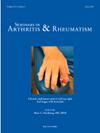Age of onset of rheumatoid arthritis and radiographic changes
IF 4.6
2区 医学
Q1 RHEUMATOLOGY
引用次数: 0
Abstract
Objectives
The association between age of rheumatoid arthritis (RA) onset and joint erosions remains unclear. We investigated the effects of age of RA onset on incident joint erosion and the progression of radiographic findings.
Methods
Patients diagnosed with RA within 2 years of enrollment in a large single-center RA registry were included. The age of RA onset was categorized into young- (≤44 years of age), middle- (45–65), and late-onset (≥66). Modified total Sharp scores (mTSS) were obtained at baseline, year 2, and year 5, and incident joint erosion was defined as an erosion score >0. Adjusted odds ratio (aOR) of incident joint erosions and adjusted change in mTSS by age category were evaluated over a 5-year follow-up period.
Results
Among 1,581 participants with RA, 284 patients within 2 years of RA diagnosis were identified. The mean mTSS were 0.54 in the young-, 3.12 in the middle-, and 4.77 in the late-onset group. The aOR of incident joint erosion in the middle-, aOR 4.0 (95 % CI 2.2 - 7.5), and the late-onset groups, 8.2 (95 % CI 3.6 - 19.2), were elevated compared with the young-onset group. Compared with the young-onset group, the adjusted changes in mTSS in the middle- group, 2.8 (95 % CI 0.20 – 5.4), and the late-onset groups, 1.9 (95 % CI -0.26 – 4.1), were elevated.
Conclusion
The odds of incident joint erosion and change in the mTSS were increased among patients with later RA onset. Age of RA onset should be considered when determining optimal management strategies.
求助全文
约1分钟内获得全文
求助全文
来源期刊
CiteScore
9.20
自引率
4.00%
发文量
176
审稿时长
46 days
期刊介绍:
Seminars in Arthritis and Rheumatism provides access to the highest-quality clinical, therapeutic and translational research about arthritis, rheumatology and musculoskeletal disorders that affect the joints and connective tissue. Each bimonthly issue includes articles giving you the latest diagnostic criteria, consensus statements, systematic reviews and meta-analyses as well as clinical and translational research studies. Read this journal for the latest groundbreaking research and to gain insights from scientists and clinicians on the management and treatment of musculoskeletal and autoimmune rheumatologic diseases. The journal is of interest to rheumatologists, orthopedic surgeons, internal medicine physicians, immunologists and specialists in bone and mineral metabolism.

 求助内容:
求助内容: 应助结果提醒方式:
应助结果提醒方式:


